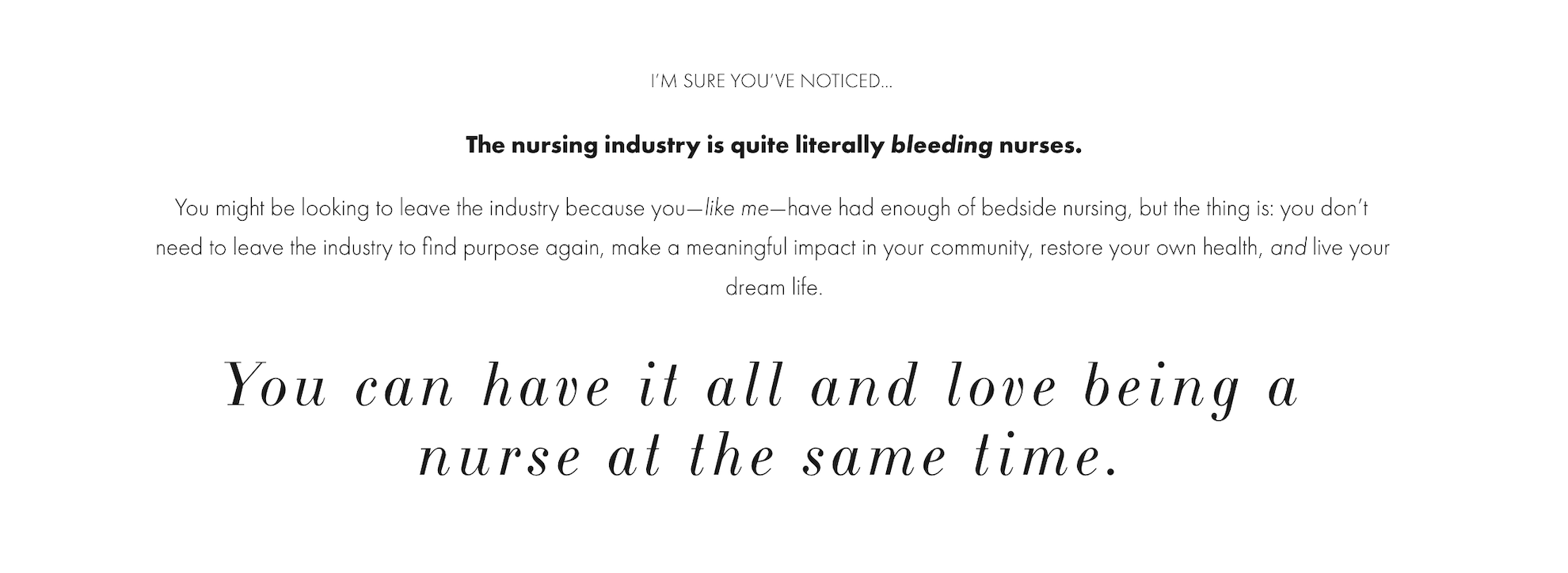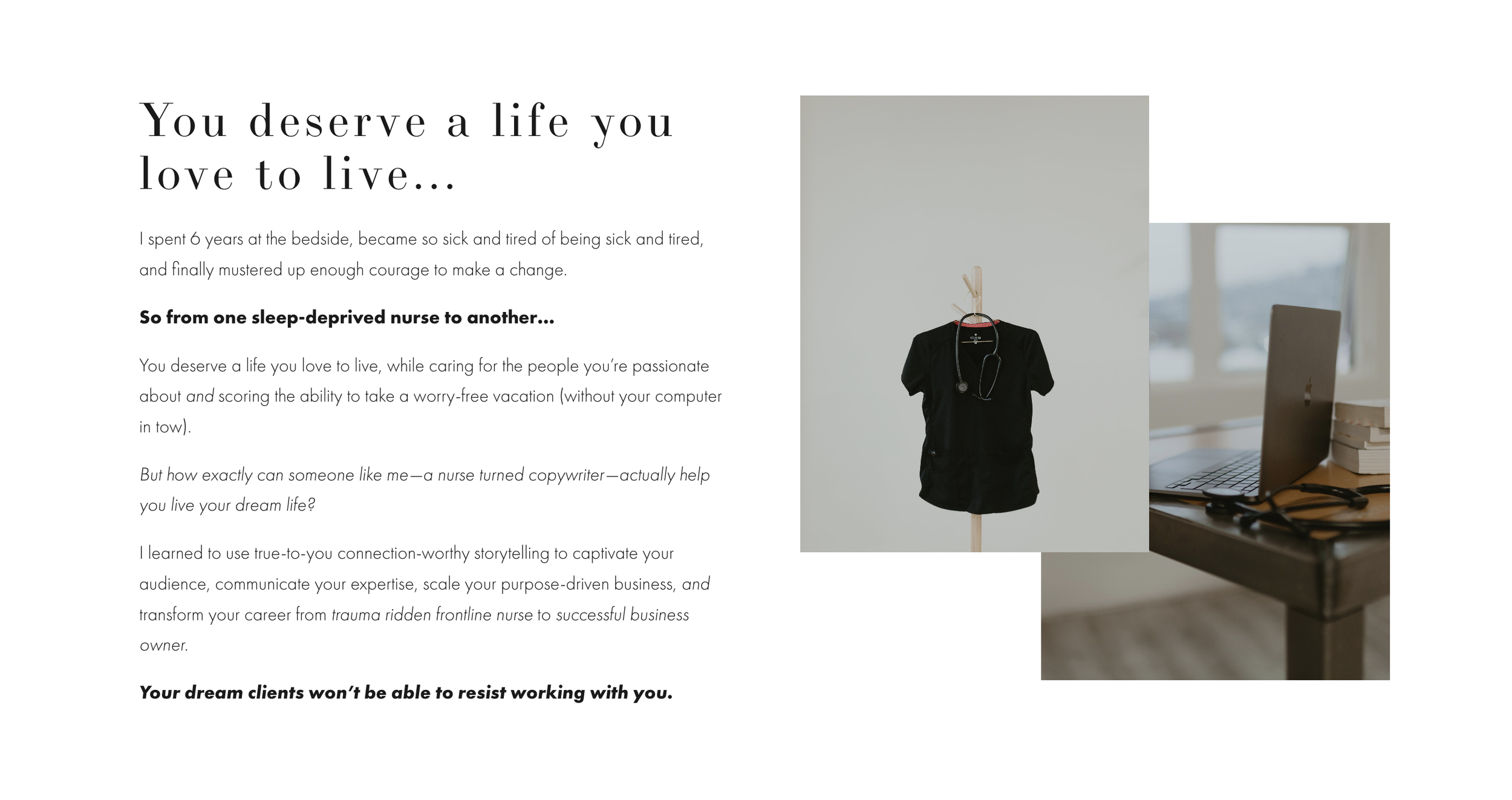Writing a good story isn’t always easy, especially when it comes to your brand and website copy.
But, it is easy to feel overwhelmed and not know where to start when you sit down to write your story — and don’t even get me started on strategic storytelling because I know we’re all on the same struggle bus there.
The thing is, as human beings, we are wired to love stories.
From the earliest cave paintings to the latest bestselling novels to the flashiest record-breaking box office movies, stories have always been integral to human culture and communication…
But not all stories are created equal…
Some hook you right away so you can’t possibly look away…
Others are painfully boring and a regular ol’ snooze-fest…
Others are confusing as hell and lose the reader before they even get to the good parts…
As a brand, telling a compelling story can transform your business and build an unbreakable connection with your audience — that’s why I love to say I write “connection-worthy” copy.
Whether you are trying to sell a product, promote a service, educate your audience, or establish a brand identity, your storytelling skills can make or break your success.
4 Tips on Writing a Better Story for Your Brand and Website Copy
1 | Verify relatability
Your brand story should have a unique voice and perspective that sets it apart from your competitors, but you should verify that the stories you write are actually relatable to your audience.
Before you start writing anything, always go back to your market research. You want to completely understand your ideal customer and what they want, need, desire, and the things that keep them up at night.
You’ll answer Q’s like:
-
What’s your target audience’s age, demographic, and income?
-
What specific challenges are they looking to overcome, and why?
-
Is your target audience aware of their pain points? Are they searching for a solution yet? Is there a demand for your product?
-
How will your product improve their life?
-
What would their life be like if they chose not to purchase your product?
So, after you’ve done your market research, you can use your brand archetypes to interlace their needs with your solution.
Remember, your brand archetype is the universal, symbolic character that represents different aspects of human nature.
By identifying your brand archetype, you can create a story that aligns with your brand’s personality and values, and once you’ve determined your brand archetype, you can use it as a guide for crafting your brand story and marketing material.
For example, if your brand archetype is the Hero, your story should have a protagonist who overcomes obstacles to achieve a goal. If your brand archetype is the Explorer, your story should have a sense of adventure and discovery.
(And for more examples, you can read this blog post where I write about all 12 brand archetypes and how writing for one can impact your marketing.)
You can read how I’ve weaved my brand archetype, the Outlaw, into my own Home page copy where I write…
And later on, I used a storytelling method called future-pacing (more on this at a later date) to highlight my audience’s desire to achieve financial freedom, live a more worry-free lifestyle, and still make an impact even if it’s not at the bedside…
I’m the Outlaw, after all — I’ll always be out here doing things a little different.
2 | Introduce conflict and how to overcome it
The role of stories in our lives goes beyond good books, catchy songs, and flashy movies.
Stories help us make sense of the world and the negative events we all encounter.
Most times we can choose to turn negative experiences into positive ones through story, and by doing so, storytelling becomes a fundamental aspect of our growth, our happiness, and even our survival.
Every story follows a basic structure (even the ones we tell ourselves).
It requires a hero, a villain (or conflict), and a happy ending.
By identifying as the hero, we can overcome obstacles and challenges and achieve our goals. By casting the negative events in our lives as the villains, we can turn them into opportunities for growth and transformation. And by creating a happy ending, we can find closure and satisfaction.
When writing your stories for your brand and marketing, your ideal customer is the hero/main character, and their primary pain point is the villain/conflict.
By defining the villain/conflict/pain point, you can create a story that speaks to your customer’s needs and shows how your product can help (the benefit).
And now that you have identified your hero and villain, it’s time to craft a compelling story.
Start by introducing your hero and describe their villain/conflict/primary pain point.
Then, use descriptive language to show how your product can help them overcome obstacles, achieve their goals, and transform their lives.
By highlighting the benefit your customer will achieve when they purchase your product, you’ve just written their happy ending — a perfect wrap to an engaging, connection-worthy story your audience will just get.
3 | Prioritize readability
I’ve said this before, and I’ll say it again…
Confusing your reader is a conversion killer.
No matter how good your story is, it will only have the desired impact if it is readable and easily understood.
Sooo, make sure that your copy is easy to understand, use short sentences and paragraphs, and don’t forget to proofread your work more times than you think is necessary before publishing it.
You want all parts of your message to connect and flow well together. Don’t assume your reader understands the connection of the ideas in your message. Use transitions that link cause and effect effortlessly.
Your story should have a clear sense of momentum, with each section of your copy leading naturally into the next. You want your reader to keep reading by keeping the story moving forward.
But again, don’t assume your reader knows everything about your product or solution (or even their pain points) because they might actually need a little more information before making a buying decision.
I also don’t want to tell you to avoid using technical language because some audiences are ready for technical language and understand your industry-specific jargon entirely.
That’s where your market research comes into play because you have to thoroughly understand your audience and their specific needs to write words that actually make sense to them.
4 | Hack your hooks
You want your story’s opening (hooks and headlines) to grab readers’ attention and make them want to continue reading.
Your brand story needs to grab your audience’s attention right from the beginning. So, writing headlines that hook your audience is absolutely necessary to get your reader to stop their scroll.
A hook is a writing technique that you can use to get your audience interested in your story. You want to grab the reader’s attention with the opening line or paragraph because that sets the tone for the rest of the story.
A good hook should create a sense of curiosity or tension that compels the reader to keep reading.
And hacking your hooks means finding creative and unexpected ways to start your story and foster that curiosity.
But you also want to ensure your hook is relevant to the story and sets the tone for what will come. You don’t want your hook to be misleading or confusing and misrepresent the story either — no one likes to be tricked.
Starting your story with a question is a great way to engage the reader’s curiosity. The question should be relevant to the story and make the reader want to know the answer. Keep the question short and sweet, and ensure it is open-ended to encourage the reader to keep reading.
Another way to grab the reader’s attention is to make a bold statement. This could be a surprising fact, a controversial opinion, or a provocative statement. The statement should be relevant to the story and create a sense of tension or curiosity that compels the reader to keep reading.
And lastly, instead of telling your audience what will happen next, show them.
Use descriptive language to create a vivid picture in their minds. Be as specific as possible and use sensory details to make your story more engaging.
Using sensory details can help your reader experience your story’s world through the five senses, and it is a powerful way to make your story more engaging and relatable.
By appealing to the reader’s senses, you can help them feel more immersed in the story. You can start by describing the sights, sounds, smells, tastes, and textures of the world you’re creating and then write about how your character (or, in this instance, your ideal client) feels at that moment.
Creating a story that connects with your audience is all about evoking strong emotions because stories that make your audience feel happy, sad, or inspired are more likely to be shared and engaged with.
So, by hacking your hooks and tapping into your audience’s emotions, you can create a powerful story that resonates with them on a deeper level, inspires them to keep reading, and drives the action you intended.
When the power of storytelling is undeniable…
Storytelling is a powerful tool for brands to connect with their audience.
By focusing on the key elements of a good story and honing your storytelling skills, you can craft narratives that capture your readers’ imaginations, communicate your ideas effectively, and convert them into loyal customers.
So keep writing, keep revising, and keep telling stories that matter.
And if you need my help to write a powerful, strategic brand story…
Ready to redefine what it means to be a nurse and scale the business of your dreams with connection-worthy copy?
More scroll-stopping content…
Hey, it’s Bridget — your website copywriting nurse bestie. Have we had a chance to connect yet?
Read my story. Get to know me a little better, because I bet we have a few things in common!
Subscribe to my newsletter. Every week, I write about ways to reinvent what it means to be a nurse, how you can still be impactful even if it’s not at the bedside, and how to DIY all your website copy to attract all your raving fans.
Get my freebie. Curious about how to get started on your journey from Bedside to Business? I compiled 50+ resources into one Notion dashboard to help you shift your mindset, push past your mental blocks, and actually get started!
Take a spin around the blog. SDN’s blog is constantly growing and a perfect place to get your hands on all the free content a nurse entrepreneur could dream of.
Check out my copywriting services. I write website copy and blog content for nurses in business and nurses with personal brands.
Want to write to me directly? Fill out my contact form, and we can chat about all your big dreams.





